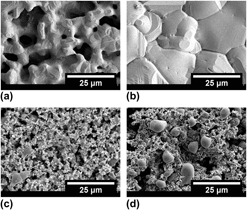Crossref Citations
This article has been cited by the following publications. This list is generated based on data provided by
Crossref.
Hughes, Gareth A.
Yakal-Kremski, Kyle
Call, Ann V.
and
Barnett, Scott A.
2012.
Durability Testing of Solid Oxide Cell Electrodes with Current Switching.
Journal of The Electrochemical Society,
Vol. 159,
Issue. 12,
p.
F858.
Sarikaya, Ayhan
Petrovsky, Vladimir
and
Dogan, Fatih
2012.
Silver Based Perovskite Nanocomposites as Combined Cathode and Current Collector Layers for Solid Oxide Fuel Cells.
Journal of The Electrochemical Society,
Vol. 159,
Issue. 11,
p.
F665.
Buyukaksoy, Aligul
Petrovsky, Vladimir
and
Dogan, Fatih
2013.
Solid Oxide Fuel Cells with Symmetrical Pt-YSZ Electrodes Prepared by YSZ Infiltration.
Journal of The Electrochemical Society,
Vol. 160,
Issue. 4,
p.
F482.
Sarikaya, Ayhan
Petrovsky, Vladimir
and
Dogan, Fatih
2013.
High Temperature Stability of Silver Based Porous Nanocomposites for Electrochemical Devices.
MRS Proceedings,
Vol. 1542,
Issue. ,
Mosiałek, Michał
Dudek, Magdalena
Michna, Aneta
Tatko, Maciej
Kędra, Aneta
and
Zimowska, Małgorzata
2014.
Composite cathode materials Ag-Ba0.5Sr0.5Co0.8Fe0.2O3 for solid oxide fuel cells.
Journal of Solid State Electrochemistry,
Vol. 18,
Issue. 11,
p.
3011.
Mahapatra, Manoj K.
and
Singh, Prabhakar
2014.
Future Energy.
p.
511.
Mosiałek, M.
Nowak, P.
Dudek, M.
and
Mordarski, G.
2014.
Oxygen reduction at the Ag|Gd0.2Ce0.8O1.9 interface studied by electrochemical impedance spectroscopy and cyclic voltammetry at the silver point electrode.
Electrochimica Acta,
Vol. 120,
Issue. ,
p.
248.
Li, Mengran
Zhao, Mingwen
Li, Feng
Zhou, Wei
Peterson, Vanessa K.
Xu, Xiaoyong
Shao, Zongping
Gentle, Ian
and
Zhu, Zhonghua
2017.
A niobium and tantalum co-doped perovskite cathode for solid oxide fuel cells operating below 500 °C.
Nature Communications,
Vol. 8,
Issue. 1,
Gao, Chenlong
Liu, Yingjun
Zhao, Teng
Wang, Wei
Tomov, R.I.
and
Vasant Kumar, R.
2017.
The effect of silver current collector on metal oxide infiltrated La 0.6 Sr 0.4 Co 0.2 Fe 0.8 O 3 /Ce 0.9 Gd 0.1 O 2 in solid oxide fuel cells application.
Nano-Structures & Nano-Objects,
Vol. 12,
Issue. ,
p.
91.
SHONG, Wei-Ja
LIU, Chien-Kuo
YANG, Peng
LEE, Ruey-Yi
and
LIN, Kin-Fu
2017.
Evaluation of Ag–NiO mixture as a cathode contact material for solid oxide fuel cell applications.
Journal of the Ceramic Society of Japan,
Vol. 125,
Issue. 4,
p.
202.
Zhu, J.H.
and
Ghezel-Ayagh, H.
2017.
Cathode-side electrical contact and contact materials for solid oxide fuel cell stacking: A review.
International Journal of Hydrogen Energy,
Vol. 42,
Issue. 38,
p.
24278.
Shong, Wei-Ja
Liu, Chien-Kuo
Lu, Chang-Wei
Wu, Szu-Han
and
Lee, Ruey-Yi
2017.
Characteristics of La0.6Sr0.4Co0.2Fe0.8O3–Cu2O mixture as a contact material in SOFC stacks.
International Journal of Hydrogen Energy,
Vol. 42,
Issue. 2,
p.
1170.
Yang, Jiajun
Li, Zhe
Yan, Dong
Pu, Jian
Chi, Bo
and
Li, Jian
2018.
The investigation of Ag & LaCo0.6Ni0.4O3−δ composites as cathode contact material for intermediate temperature solid oxide fuel cells.
International Journal of Hydrogen Energy,
Vol. 43,
Issue. 28,
p.
12705.
DEMİRKAL, Emrah
and
BÜYÜKAKSOY, Aligül
2019.
EFFECT OF FRIT CONTENT IN THE SILVER CURRENT COLLECTOR INKS ON THE ELECTROCHEMICAL PERFORMANCE OF SOLID OXIDE FUEL CELL CATHODES.
Mühendislik Bilimleri ve Tasarım Dergisi,
Vol. 7,
Issue. 4,
p.
796.
Shen, Minghai
and
Zhang, Panpan
2020.
Progress and challenges of cathode contact layer for solid oxide fuel cell.
International Journal of Hydrogen Energy,
Vol. 45,
Issue. 58,
p.
33876.
Shin, Ji-Weon
Lee, Dong-Young
Hussain, Amjad
Joh, Dong-Woo
Hong, Jong-Eun
Park, Seok-Joo
Lee, Seung-Bok
Song, Rak-Hyun
Huh, Joo-Youl
Mehran, Muhammad Taqi
Kim, Hye-Sung
and
Lim, Tak-Hyoung
2024.
Highly robust and porous cathode current collecting layer for flat-tubular solid oxide fuel cell stack applications.
Ceramics International,



